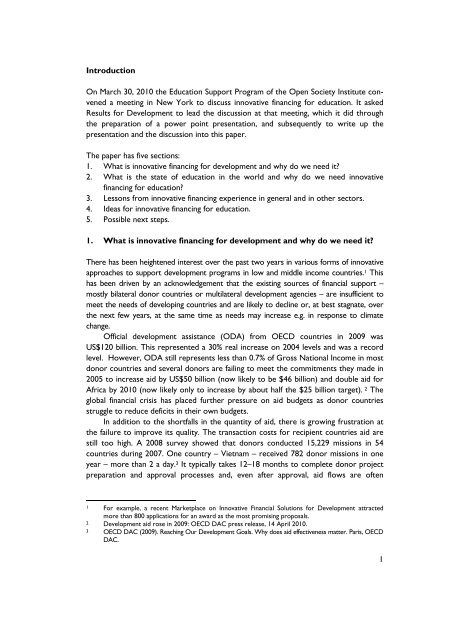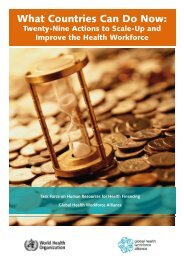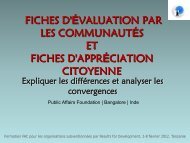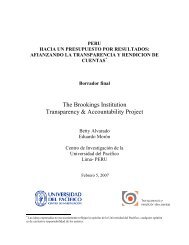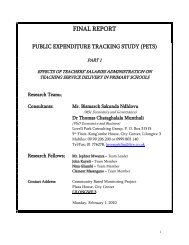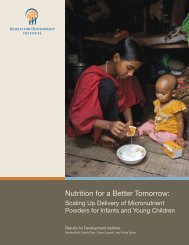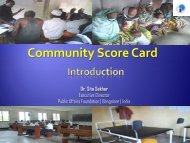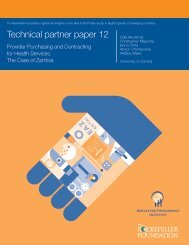Innovative Financing for Education - Burnett & Bermingham.pdf
Innovative Financing for Education - Burnett & Bermingham.pdf
Innovative Financing for Education - Burnett & Bermingham.pdf
You also want an ePaper? Increase the reach of your titles
YUMPU automatically turns print PDFs into web optimized ePapers that Google loves.
Introduction<br />
On March 30, 2010 the <strong>Education</strong> Support Program of the Open Society Institute convened<br />
a meeting in New York to discuss innovative financing <strong>for</strong> education. It asked<br />
Results <strong>for</strong> Development to lead the discussion at that meeting, which it did through<br />
the preparation of a power point presentation, and subsequently to write up the<br />
presentation and the discussion into this paper.<br />
The paper has five sections:<br />
1. What is innovative financing <strong>for</strong> development and why do we need it?<br />
2. What is the state of education in the world and why do we need innovative<br />
financing <strong>for</strong> education?<br />
3. Lessons from innovative financing experience in general and in other sectors.<br />
4. Ideas <strong>for</strong> innovative financing <strong>for</strong> education.<br />
5. Possible next steps.<br />
1. What is innovative financing <strong>for</strong> development and why do we need it?<br />
There has been heightened interest over the past two years in various <strong>for</strong>ms of innovative<br />
approaches to support development programs in low and middle income countries. 1 This<br />
has been driven by an acknowledgement that the existing sources of financial support –<br />
mostly bilateral donor countries or multilateral development agencies – are insufficient to<br />
meet the needs of developing countries and are likely to decline or, at best stagnate, over<br />
the next few years, at the same time as needs may increase e.g. in response to climate<br />
change.<br />
Official development assistance (ODA) from OECD countries in 2009 was<br />
US$120 billion. This represented a 30% real increase on 2004 levels and was a record<br />
level. However, ODA still represents less than 0.7% of Gross National Income in most<br />
donor countries and several donors are failing to meet the commitments they made in<br />
2005 to increase aid by US$50 billion (now likely to be $46 billion) and double aid <strong>for</strong><br />
Africa by 2010 (now likely only to increase by about half the $25 billion target). 2 The<br />
global financial crisis has placed further pressure on aid budgets as donor countries<br />
struggle to reduce deficits in their own budgets.<br />
In addition to the shortfalls in the quantity of aid, there is growing frustration at<br />
the failure to improve its quality. The transaction costs <strong>for</strong> recipient countries aid are<br />
still too high. A 2008 survey showed that donors conducted 15,229 missions in 54<br />
countries during 2007. One country – Vietnam – received 782 donor missions in one<br />
year – more than 2 a day. 3 It typically takes 12–18 months to complete donor project<br />
preparation and approval processes and, even after approval, aid flows are often<br />
1 For example, a recent Marketplace on <strong>Innovative</strong> Financial Solutions <strong>for</strong> Development attracted<br />
more than 800 applications <strong>for</strong> an award as the most promising proposals.<br />
2 Development aid rose in 2009: OECD DAC press release, 14 April 2010.<br />
3 OECD DAC (2009). Reaching Our Development Goals. Why does aid effectiveness matter. Paris, OECD<br />
DAC.<br />
1


